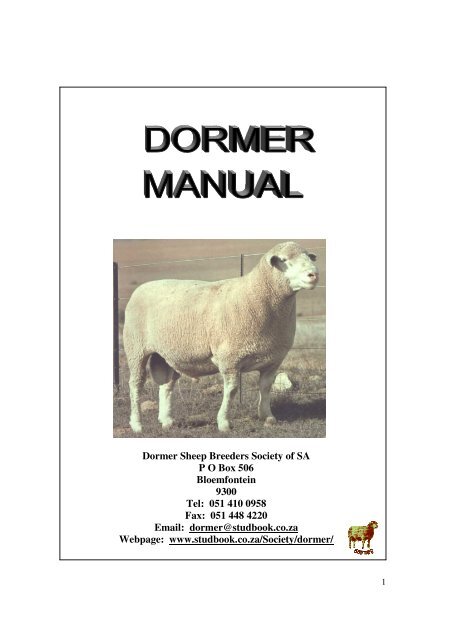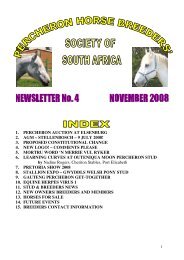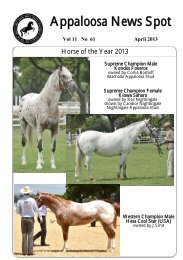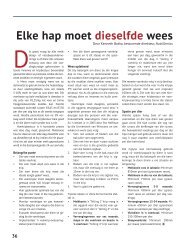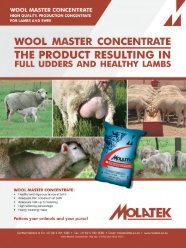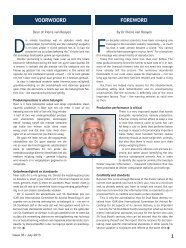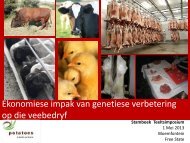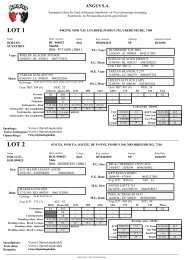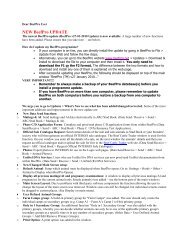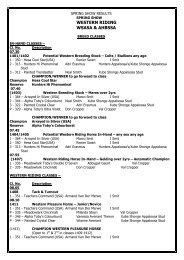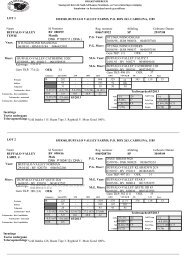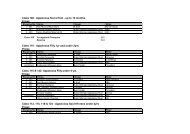Dormer Sheep Breeders Society of SA P O Box 506 Bloemfontein ...
Dormer Sheep Breeders Society of SA P O Box 506 Bloemfontein ...
Dormer Sheep Breeders Society of SA P O Box 506 Bloemfontein ...
Create successful ePaper yourself
Turn your PDF publications into a flip-book with our unique Google optimized e-Paper software.
<strong>Dormer</strong> <strong>Sheep</strong> <strong>Breeders</strong> <strong>Society</strong> <strong>of</strong> <strong>SA</strong><br />
P O <strong>Box</strong> <strong>506</strong><br />
<strong>Bloemfontein</strong><br />
9300<br />
Tel: 051 410 0958<br />
Fax: 051 448 4220<br />
Email: dormer@studbook.co.za<br />
Webpage: www.studbook.co.za/<strong>Society</strong>/dormer/<br />
1
1. THE ESTABLISHMENT AND DEVELOPMENT OF THE DORMER BREED<br />
The <strong>Dormer</strong> is a South African bred white woolled mutton sheep developed after<br />
years <strong>of</strong> intensive research at the Elsenburg Agricultural College from the crosses <strong>of</strong><br />
Dorset Horn rams and German Merino ewes.<br />
The purpose <strong>of</strong> the development <strong>of</strong> the breed was to breed an early maturing sheep<br />
breed that can produce affordable meat at an early age; that would be well adapted to<br />
conditions in the winter rainfall area and that could compete with Australian and New<br />
Zealand lambs at the Smithfield market in England. The further purpose was to<br />
produce suitable rams for cross breeding, especially with the Merino and it was<br />
therefore decided to create a white woolled mutton breed, free <strong>of</strong> kemp and coloured<br />
fibres.<br />
2. SLAUGHTER LAMB TRIALS AT ELSENBURG<br />
Since 1927, for more than 10 years, rams <strong>of</strong> the following breeds were mated to<br />
Merino ewes which were the most readily available at the time: Dorset Horn, Border<br />
Leicester, Ryeland, Romney Marsh, South Down, Suffolk Down, (British mutton<br />
breeds) as well as Texel, Corriedale, German Merino and Blackhead Persian.<br />
Thereafter German Merino X Merino ewes were mated to Dorset Horn rams and it<br />
was found that the progeny were heavier than any other cross lambs. The above<br />
results gave rise to the mating <strong>of</strong> German Merino ewes to Dorset Horn rams. In<br />
addition to the unique traits <strong>of</strong> German Merino ewes, they could also, like the Merino<br />
and Dorset Horn, easily lamb in the fall with an acceptable lambing percentage.<br />
Experiments carried out proved that Dorset Horn X German Merino lambs excelled<br />
as slaughter lambs.<br />
3. COOPERATIVE EXPERIMENTS IN THE WINTER RAINFALL REGION<br />
The excellent results obtained from the Elsenburg slaughter lamb trials gave rise to<br />
the decision to carry out similar trials at a cooperative level and to develop it amongst<br />
farmers in the region, with the view <strong>of</strong> establishing a pr<strong>of</strong>itable slaughter lamb<br />
industry, directed at the overseas market.<br />
During 1936 and 1937 a couple <strong>of</strong> hundred mutton rams were imported from<br />
Australia and England and primarily crossed with Merino ewes. In excess <strong>of</strong> 6000<br />
lamb carcasses were thereafter exported to the Smithfield market. Extensive trials<br />
proved the Dorset Horn ram to be the best mutton ram for slaughter lamb production.<br />
The small Meullerius lungworm was however causing problems. The Dorset Horn<br />
and German Merino studs founded in 1923 and 1932 respectively and which were<br />
kept at Elsenburg under similar conditions, could be compared in respect <strong>of</strong> its<br />
susceptibility and resistance to lungworm. It was concluded that the German Merino<br />
had a stronger resistance against lungworm and that in the case <strong>of</strong> the Dorset Horn, it<br />
could possibly be hereditary.<br />
2
4. PLANNING OF THE ESTABLISHMENT OF A NEW BREED<br />
Mr LH Bartel who actively strived towards the establishment <strong>of</strong> a slaughter lamb<br />
industry in the winter rainfall region, came with the suggestion that a new breed must<br />
be established from the Dorset Horn and German Merino, to replace the Dorset Horn<br />
as slaughter lamb producer.<br />
Attempts were made to combine the mutton traits and growth ability <strong>of</strong> the Dorset<br />
Horn with the strong resistance against lungworm <strong>of</strong> the German Merino and to fuse<br />
it into the proposed new breed. Both breeds possessed the much sought after<br />
characteristics <strong>of</strong> high fertility, fecundity, milk production and an extended breeding<br />
season.<br />
On 18 October 1940 ten Dorset Horn rams were imported from Australia, sponsored<br />
by the Control Board for the <strong>Sheep</strong> Stock industry. Subsequent to strict screening on<br />
conformation and type, only four rams were selected to be mated to stud and grade<br />
German Merino ewes at Elsenburg.<br />
Only the two top performing rams were used in the subsequent mating season. No<br />
further cross breeding <strong>of</strong> Dorset Horn X German Merino were done subsequent to<br />
1941. The first generation (F1) ram and ewe lambs were to serve as basic material<br />
for building the new breed.<br />
5. PROGENY TESTING OF RAMS<br />
Rams render the most significant contribution towards the improvement <strong>of</strong> a flock<br />
and for this reason it was decided to first test the F1 ram lambs prior to using them in<br />
the new flock.<br />
In 1941 eight <strong>of</strong> the best F1 ram lambs representatives <strong>of</strong> the said four Dorset Horn<br />
rams were selected. At 7 months they were each put with 20 grade German Merino<br />
ewes for the purpose <strong>of</strong> mating. In this way their breeding value for slaughter lamb<br />
production could be determined. The main selection criteria from the outset were an<br />
early maturing slaughter lamb with excellent conformation.<br />
The best two rams from the initial eight were then identified for use in the flock on<br />
account <strong>of</strong> their breeding performance with regard to growth, carcass quality, grading,<br />
fat distribution, conformation and lung worm resistance. To avoid inbreeding it was<br />
agreed to mate F1 rams, the progeny <strong>of</strong> ram no. 4, with selected F1 ewes <strong>of</strong> ram<br />
no. 37 and vice versa. Attempts were made at all times to avoid close inbreeding.<br />
6. EXCELLENT BREEDING PERFORMANCE<br />
Notwithstanding a considerable workload and substantial record keeping the testing<br />
<strong>of</strong> young rams on grade ewes prior to being used in the flock was maintained for<br />
many years and generations. The new breed was less susceptible to lungworm –<br />
thanks also to research that was carried out on the lungs <strong>of</strong> lambs slaughtered for<br />
progeny testing. Results obtained from cooperative trials and farmers in the winter<br />
rainfall area proved that the breed was convincingly suited to the winter rainfall<br />
3
egion and that, in a cross breeding program, it will produce the type <strong>of</strong> slaughter<br />
lamb sought after by breeders.<br />
Mr LH Bartel, the architect <strong>of</strong> the new breed, passed away in 1944 upon which this<br />
project was passed on to Mr JF du Toit. He in turn passed away in 1947 where after<br />
Mr IL Ferreira took over. Mr Ferreira was the master builder <strong>of</strong> the breed and until<br />
his retirement in 1981, he executed this task with loyalty, purposefulness and in an<br />
ever-humble fashion.<br />
After 25 years <strong>of</strong> careful record keeping, strict selection, unsurpassed dedication,<br />
production recording and without introducing any new or foreign blood, the breed<br />
traits and type were established to such an extent that the <strong>Dormer</strong> was in 1975, after<br />
seven generations, registered with the <strong>SA</strong> Stud Book as an independent breed.<br />
7. DORMER TODAY<br />
Although the <strong>Dormer</strong> was primarily bred for use in the winter rainfall region, it<br />
proved to be highly adaptable to other regions and is therefore being used in all<br />
regions <strong>of</strong> South Africa for slaughter lamb production.<br />
In an attempt to promote and improve the breed, courses are regularly being presented<br />
and breeders participate at shows and exhibitions as well as slaughter lamb<br />
competitions. The National <strong>Dormer</strong> sale takes place annually during September in<br />
<strong>Bloemfontein</strong>.<br />
Stud breeders are compelled to participate in production recording and the <strong>Dormer</strong><br />
<strong>Society</strong> was the very first to rule that only production recorded animals may be sold<br />
at the National <strong>Dormer</strong> Sale.<br />
8. THE DORMER HOLDS ALL THE ECONOMICALLY IMPORTANT<br />
TRAITS TO BE CATEGORIZED AS THE IDEAL MUTTON BREED<br />
8.1 CONFORMATION<br />
The Ideal <strong>Dormer</strong> is an energetic, smooth bodied, white woolled sheep with good<br />
muscling, good length, width, and depth, well filled hindquaters, well developed<br />
loins, strong topline, a head displaying good character, with strong bones and well<br />
pigmented eyelids, with stong well places legs, strong pasterns and healthy hooves.<br />
The animal should stand reasonably high for ease <strong>of</strong> movement.<br />
8.2 FERTILITY AND UNLIMITED BREEDING CYCLE<br />
Fertility is one <strong>of</strong> the breed’s strong points and breeders specifically select for<br />
multiple births. Twins are preferable although triplets are common; quadruplets,<br />
quintuples and even sextuplets have been recorded. A lambing percentage <strong>of</strong> 150%<br />
and higher is quite common (lambs born in comparison with ewes mated). Large<br />
numbers <strong>of</strong> surplus lambs ensure the pr<strong>of</strong>itability <strong>of</strong> the industry. This also broadens<br />
the selection base which in turn speeds up genetic improvement. The unlimited<br />
breeding cycle facilitates more than one harvest per year and the lambing season can<br />
4
e managed in order to utilize maximum pastures.<br />
8.3 MOTHERING TRAITS, MILK PRODUCTION, GROWTH RATE<br />
Outstanding mothering traits ensure a high growth rate and weaning percentage.<br />
<strong>Dormer</strong> lambs generally maintain an average daily gain <strong>of</strong> 400gr up to 100 days, but<br />
gains <strong>of</strong> up to 500gr are not uncommon. The weight <strong>of</strong> the lamb at 42 days is a true<br />
reflection <strong>of</strong> the milk production <strong>of</strong> the dam while the mass from 42 - 100 days<br />
indicate the inherent growth ability <strong>of</strong> the lamb.<br />
8.4 EARLY MATURITY<br />
Early maturity ensures a slaughter lamb ready for market at an early age which<br />
produces a quality carcass <strong>of</strong> 16 – 22 kg at 3 months. This characteristic is also<br />
sought after where cross breeding is done for slaughter lamb production with late<br />
maturing breeds such as the Merino. The benefits <strong>of</strong> early maturity are that lambs<br />
may be marketed at an early age, that ewes can be rested more <strong>of</strong>ten and can produce<br />
more wool, that more ewes can be kept per hectare and that it is only necessary to<br />
carry mature animals when pastures are poor.<br />
Young ewes are able to lamb from 12 – 18 months which results in an increased<br />
turnover and which limits the generation interval.<br />
8.5 SLAUGHTER LAMB PRODUCTION AND CROSS BREEDING<br />
Outstanding conformational traits, carcass qualities, early maturity, growth speed,<br />
fertility, mothering abilities, milk production, unlimited breeding cycle and its ability<br />
to adapt puts the <strong>Dormer</strong> first as the ideal breed for slaughter lamb production.<br />
Because the <strong>Dormer</strong> is able to transfer its conformational traits to late maturing<br />
breeds and the relatively small lamb at birth, this breed is very well suited to cross<br />
breeding with other breeds. Because it is a white woolled breed, free <strong>of</strong> kemp and<br />
colored fibres the breed is recommended for cross breeding with the Merino for<br />
slaughter lamb production.<br />
With both the champion and reserve champion at the National Slaughter lamb<br />
competition in Moorreesburg were sired by a <strong>Dormer</strong> ram and this once more<br />
confirmed the popularity <strong>of</strong> the <strong>Dormer</strong> ram as cross breeding sire. The champion<br />
lamb (<strong>Dormer</strong> X S A Mutton Merino) with a live mass <strong>of</strong> 40 kg at three months, a<br />
carcass mass <strong>of</strong> 22.8kg and a slaughter percentage <strong>of</strong> 57% also displayed the ideal<br />
conformation with good muscling and smooth far distribution.<br />
8.6 WOOL PRODUCTION<br />
Meat production being the main aim wool is considered a bonus and pay for<br />
expenses in respect <strong>of</strong> shearing, inoculations, dosing and other running costs. (at 12<br />
months 4-5kg wool per mature sheep is shorn with a length <strong>of</strong> 10cm, a fibre diameter<br />
<strong>of</strong> 27 micron and a clean yield <strong>of</strong> ± 60%.<br />
The white wool free <strong>of</strong> kemp and colored fibres facilitates cross breeding with other<br />
5
white woolled breeds. Interesting to note that <strong>Dormer</strong> ewes generally do not lose<br />
their belly wool during lactation.<br />
8.7 ADAPTATION AND FEED CONVERSION<br />
The <strong>Dormer</strong> was initially bred for the intensive conditions <strong>of</strong> the winter rainfall<br />
region but has since been established in all areas <strong>of</strong> South Africa and is indeed<br />
thriving even under extensive conditions.<br />
<strong>Dormer</strong>s are calm non selective eaters and will not damage the veldt unnecessarily.<br />
The ability <strong>of</strong> the breed to convert low quality roughage to quality meat makes it a<br />
very adaptable breed also under extensive conditions and therefore a very efficient<br />
user <strong>of</strong> roughage. Efficient feed conversion under intensive conditions makes the<br />
<strong>Dormer</strong> the ideal breed for economic slaughter lamb production.<br />
8.8 ENERGY AND LIFE SPAN<br />
<strong>Dormer</strong> lambs are relatively small at birth (4kg) but they are energetic and increase<br />
their mass very quickly. The survival <strong>of</strong> lambs from birth to weaning influences to a<br />
large extent the net reproduction performance <strong>of</strong> a breeding flock and therefore also<br />
the pr<strong>of</strong>it margin. Survival rate is not highly heritable and good management and<br />
care are therefore very important to ensure the highest possible weaning percentage.<br />
8.9 EASY CARE AND TEMPERAMENT<br />
The calm and peaceful nature <strong>of</strong> the <strong>Dormer</strong> makes it easy to handle and manage and<br />
fits in well with modern farming techniques. The smooth bodies and legs and open<br />
faces minimizes attacks from flies and blowflies. <strong>Dormer</strong>s are easily shorn because<br />
<strong>of</strong> its smooth body and if machine shorn; they present a very handsome picture with a<br />
wool growth <strong>of</strong> 6-8 weeks. In respect <strong>of</strong> shows and sales wool must not be longer<br />
than 3 cm.<br />
On account <strong>of</strong> small lambs at birth, <strong>Dormer</strong> ewes find it easy to lamb and are<br />
excellent mothers.<br />
8.10 GENERAL<br />
Courses are presented regularly to introduce and promote the breed and members<br />
participate at slaughter lamb competitions, shows and exhibitions. The National<br />
<strong>Dormer</strong> sale is presented annually in <strong>Bloemfontein</strong>.<br />
6
9. DORMER – MINIMUM BREED STANDARDS<br />
1. Head<br />
Ideal Deviations Cull faults<br />
Fine head, fine jaw, wool<br />
on head(crest) not lower<br />
than the eye-line; too little<br />
pigment on the eyes, dull<br />
expression in the eyes and<br />
strong fixed heavy horns<br />
on rams(less than 3cms).<br />
Kemp on the face is<br />
permissible.<br />
Displaying good character,<br />
hornless, strong, moderate<br />
length, with a broad strong<br />
mouth, and well-formed<br />
teeth and jaw; pigmented<br />
eyelids, with alert eyes and<br />
ears <strong>of</strong> medium size with a<br />
s<strong>of</strong>t white covering on both<br />
ears and face.<br />
Broad, well attached with<br />
the head, shoulders and<br />
breast, with good length;<br />
no neck pleats nor vertical<br />
or horizontal dewlap on the<br />
neck.<br />
Jaw faults: too short or too<br />
long lower-jaw; skew jaw,<br />
abnormal teeth (feed-jaw<br />
more than 3mm); folded-in<br />
eyelids, excess pink around<br />
eyes and ears without<br />
pigmentation (red-face<br />
appearance); no pigmentation<br />
on both rams and ewes;<br />
excessive heavy horns (base<br />
3 cm and length 3cm.); horn<br />
nobs on ewes; wool on head<br />
(crest) lower than eye-line.<br />
2. Neck<br />
Ideal Deviations Cull faults<br />
Moderate dewlap and neck<br />
pleats<br />
Broad, deep and better<br />
developed in the rams than<br />
in the ewes.<br />
Too short or too long neck<br />
with a weak attachment with<br />
the shoulders (u-shaped).<br />
Diagonal pleats on the neck<br />
down to the chest.<br />
3. Fore quarter<br />
Ideal Deviations Cull faults<br />
Moderate deviation from<br />
the ideal.<br />
Too small and lack <strong>of</strong> depth<br />
and breadth; poor<br />
development <strong>of</strong> the fore<br />
quarter.<br />
4. Withers and shoulders<br />
Ideal Deviations Cull faults<br />
Moderate loose shoulders.<br />
Broad, full, even and well<br />
attached to the middle<br />
piece and neck.<br />
Loose shoulders, sharp or<br />
pinched shoulders (devil’s<br />
grip)<br />
5. Middle piece<br />
5.1 Back and loins<br />
Ideal Deviations Cull faults<br />
Straight back (top line),<br />
strong and broad. Loins in<br />
line with back and rump,<br />
with good muscling over<br />
the back and loins.<br />
Lack <strong>of</strong> length, breadth and<br />
depth as well as lack <strong>of</strong><br />
muscling.<br />
Hollow or crooked back,<br />
weak muscling and lack <strong>of</strong><br />
muscling and breadth.<br />
7
5.2 Rib and flank<br />
Ideal Deviations Cull faults<br />
Slightly weaker spring <strong>of</strong><br />
ribs<br />
Good spring <strong>of</strong> ribs<br />
(capacity), deep and full in<br />
the flanks. Ewes wedgeshaped.<br />
Flat ribs, lack <strong>of</strong> depth and<br />
breadth and cut up in the<br />
flanks(cylindrical)<br />
6. Hind quarter<br />
6.1 Rump<br />
Ideal Deviations Cull faults<br />
Good length <strong>of</strong> rump<br />
(between thurls and pinbones),<br />
well muscled and<br />
broad between hipbones,<br />
Outer- as well as inner<br />
twist well and deeply<br />
fleshed (muscling), broad<br />
back and sides with good<br />
muscling.<br />
Too flat, too short and<br />
sloping rump. Moderate<br />
localised fat deposition in<br />
older ewes.<br />
Extreme sloping or ro<strong>of</strong><br />
shaped rump. Tapered rump<br />
with fat localisation on and<br />
between the sit-bones.<br />
6.2 Buttocks and thighs<br />
Ideaal Deviations Cull faults<br />
Slightly lacking in fleshing<br />
in outer and inner twist<br />
(poorer muscling), fat<br />
localisation especially on<br />
inner twist.<br />
Legs strong and squarely<br />
placed, <strong>of</strong> medium length,<br />
Hooves strong and amber<br />
coloured; pasterns short<br />
and strong.<br />
Poor muscling in inner- and<br />
outer-twist, excess fat<br />
localisation, especially in the<br />
inner twist.<br />
6.3 Legs and hooves<br />
Ideal Deviations Cull faults<br />
Hooves slightly open on<br />
the front legs. Slightly<br />
straight hocked. Slightly<br />
cow-hocked (hind legs).<br />
Slightly X-legged or bowlegged<br />
(front legs). Black<br />
hooves with white stripes<br />
through the hooves.<br />
Pasterns moderately long<br />
or weak.<br />
Hind legs thin, narrow<br />
stance, cow hocks, sickle<br />
shaped or too perpendicular.<br />
Front legs thin, narrow or X-<br />
shaped. Excessively cloven<br />
black hooves (eight black<br />
hooves), grown out too long,<br />
pasterns too long and/or too<br />
weak.<br />
7. Genital organs - ewes<br />
Ideal Deviations Cull faults<br />
Little pigment on genital<br />
organs, udder and teats.<br />
Well formed udder with<br />
normal sized teats.<br />
Pigmentation on female<br />
genital organs.<br />
Absence <strong>of</strong> one or both teats,<br />
dry teat, abscess in udder.<br />
Udder <strong>of</strong> which only one side<br />
is functional. Excessively<br />
large or too small teats.<br />
Poorly formed udders<br />
(drooping).<br />
8
8. Genital organs - Rams<br />
Ideal Deviations Cull faults<br />
Scrotum slightly too short,<br />
too long, too small or<br />
cloven<br />
Both testicles present, <strong>of</strong><br />
normal and even size,<br />
scrotum without split.<br />
Scrotum circumference:<br />
12 - 15 months - 30cm<br />
15 - 18 months - 32 cm<br />
19 months & older- 33cm<br />
9. Fat covering<br />
Use discretion with pregnant ewes and older animals<br />
The absence <strong>of</strong> one or both<br />
testicles, or that differ in size.<br />
Abnormally or too deeply<br />
cloven scrotum (more than<br />
3 cm). Enlarged epididymus<br />
and abscesses in the scrotum.<br />
Scrotum circumference<br />
smaller than minimum size<br />
for age. Scrotum too<br />
long(pendulous),<br />
Ideal Deviations Cull faults<br />
Medium fat localization Excessive fat localization<br />
Correct fat covering with<br />
even fat distribution.<br />
10. Wool<br />
Wool length for National Sale and National – Provincial – and Regional shows:<br />
Maximum 3cm.<br />
Ideal Deviations Cull faults<br />
White wool, free <strong>of</strong> kemp<br />
and coloured fibres in the<br />
fleece.<br />
Strong, hairy fibres in the<br />
buttock. Kemp is allowed<br />
on face and around genital<br />
organs.<br />
Kemp or coloured fibres in<br />
wool.<br />
11. Pigment<br />
Ideal Deviations Cull faults<br />
Too little pigmentation.<br />
Small patches <strong>of</strong> black or<br />
brown pigment the mouth<br />
and nose(less than 1cm).<br />
Patches on ears with black<br />
or brown hair, less than<br />
2cm. Dark skin pigment as<br />
broad as 1cm around the<br />
eyes is acceptable provided<br />
it touches the eyelid.<br />
Pale pink skin covering<br />
with pigmented eyelids and<br />
on female genital organs<br />
No pigmentation around eyes<br />
in rams and ewes. Patches on<br />
ears with black or brown<br />
hair, exceeding 2cm. Black<br />
or brown patches on the<br />
legs(sandy legs). Smaller<br />
patches <strong>of</strong> black or brown<br />
pigment around the mouth<br />
and nose that exceeds 1cm.<br />
NB.:- When judging or inspecting a sheep, do not limit yourself to single traits, but<br />
rather see the animal in its entirety.<br />
9
10. AFKEURKODES / CULLING CODES<br />
<br />
<br />
<br />
<br />
<br />
!"<br />
!<br />
!#<br />
!$<br />
%&<br />
%'<br />
%(<br />
%<br />
%)<br />
%*<br />
%+<br />
&%<br />
&<br />
& &<br />
&,<br />
&-<br />
&!<br />
&.<br />
&#<br />
&+<br />
&$<br />
*!<br />
*%<br />
*&<br />
*<br />
*#<br />
*/<br />
*0<br />
*1<br />
*$<br />
2<br />
&<br />
*<br />
"<br />
#<br />
$<br />
)'<br />
)!<br />
),<br />
)3<br />
).<br />
),<br />
)<br />
)#<br />
)4<br />
)+<br />
)<br />
<br />
<br />
<br />
<br />
<br />
<br />
<br />
<br />
<br />
<br />
<br />
<br />
<br />
<br />
<br />
<br />
<br />
<br />
<br />
<br />
<br />
5<br />
<br />
<br />
<br />
<br />
<br />
<br />
<br />
<br />
!<br />
<br />
<br />
<br />
<br />
<br />
<br />
<br />
<br />
<br />
<br />
<br />
<br />
<br />
<br />
<br />
<br />
<br />
<br />
<br />
" <br />
10
6<br />
7<br />
<br />
7<br />
<br />
<br />
11. PUNTESTELSEL/POINT SYSTEM<br />
+ <br />
9<br />
!<br />
:<br />
1<br />
;<br />
! <br />
<<br />
1 <br />
=<br />
. ><br />
#<br />
?<br />
!<br />
@<br />
+ <br />
A<br />
<br />
$ 8<br />
$ &<br />
$ 0<br />
<br />
<br />
<br />
<br />
<br />
<br />
<br />
<br />
#<br />
$ <br />
% <br />
& <br />
& <br />
' <br />
'<br />
$<br />
# <br />
12. REGISTRATION, RECORD KEEPING, GENERAL<br />
12.1 REGISTRATION<br />
12.1.1 Application to be registered as a <strong>Dormer</strong> breeder is made with<br />
The <strong>Dormer</strong> <strong>Sheep</strong> breeders society <strong>of</strong> <strong>SA</strong><br />
<strong>Box</strong> <strong>506</strong>, <strong>Bloemfontein</strong> 9300<br />
Tel: 051-410 0958<br />
Fax: 051-448 4220<br />
12.1.2 Transfers (sales)<br />
The seller must advise the <strong>Dormer</strong> <strong>of</strong>fice <strong>of</strong> animals that are sold and must furnish the date<br />
<strong>of</strong> sale, numbers <strong>of</strong> registered animals and whether some <strong>of</strong> the animals are eligible for<br />
registration and the name an address <strong>of</strong> the purchaser.<br />
Application for transfer must be done within 30 days after delivery and the certificates <strong>of</strong><br />
the relevant animals must accompany the application for transfer.<br />
12.1.3 Notice <strong>of</strong> cancellation<br />
Should a registered animal or one eligible or registration be castrated or sterilised or not<br />
have lambed prior to three years, be slaughtered or be sold for purposes <strong>of</strong> slaughter, have<br />
died, etc. the <strong>of</strong>fice must be advised within 30 days. The registration certificates <strong>of</strong> the<br />
relevant animals must be submitted to the <strong>Dormer</strong> <strong>of</strong>fice together with the notice <strong>of</strong><br />
cancellation as well as the date on which the registration should be cancelled.<br />
Levy lists are sent out by Stud book during April. You must delete all animals not in your<br />
possession at that stage. The print out must then be returned to Stud Book prior to the end<br />
11
<strong>of</strong> June. Should you fail to return the checked list, your account will be debited with all<br />
animals in your possession according to the records <strong>of</strong> Stud Book. For your convenience<br />
inspection print outs are forwarded to members during March and October to assist you<br />
with keeping your record up to date. These lists are also used for inspection purposes.<br />
12.2 RECORD KEEPING<br />
Mating lists Lamb book (book <strong>of</strong> your choice) Birth notification book<br />
At mating time a<br />
list is drawn up<br />
indicating which<br />
ewes had been<br />
mated to which<br />
rams This<br />
requirement<br />
facilitates the<br />
identification <strong>of</strong><br />
each lamb at birth.<br />
The following must be recorded<br />
within two days after birth –<br />
Identification number <strong>of</strong> the lamb,<br />
recorded in numerical order and<br />
starting at 1 each year.<br />
Date <strong>of</strong> birth <strong>of</strong> the lamb<br />
The sex <strong>of</strong> the lamb<br />
Birth status (single, twin or triplet)<br />
Birth mass (optional)<br />
Number <strong>of</strong> dam<br />
Number <strong>of</strong> sire<br />
Remarks i.e. died at birth, or any<br />
other deviation <strong>of</strong> the lamb or ewe<br />
i.e. milk, ewe ill, etc.<br />
A birth notification book must be<br />
obtained from the <strong>Dormer</strong> <strong>Society</strong>. All<br />
lambs, dead or alive, must be notified<br />
within 200 days after birth. Service<br />
certificates must accompany the birth<br />
notifications <strong>of</strong> lambs begotten from sires<br />
not in possession <strong>of</strong> the owner.<br />
The birth notifications <strong>of</strong> lambs begotten<br />
from AI must be endorsed accordingly<br />
and must be accompanied by an<br />
insemination certificate. Requirements<br />
for AI are set out in the society’s<br />
constitution<br />
12.2.1 MARKING SYSTEM OF DORMERS<br />
a) Ear coding<br />
The sequence number <strong>of</strong> lambs must be ear coded within two days after birth <strong>of</strong> the lamb.<br />
Each year starts at number 1. A special tool is used to make a cut in the ear to indicate a<br />
certain figure. This is a clear and permanent identification for life. (See attached<br />
example).<br />
b) Tags<br />
Tags must likewise be inserted within two days after birth preferably in the left ear. Any<br />
one <strong>of</strong> or both the above identification methods may be used. However Tattooing is<br />
actually the recognised identification method. All lambs must be tattooed before the age<br />
<strong>of</strong> 10 months.<br />
12
TOP OF TAG<br />
Identification letter <strong>of</strong> breeder<br />
Abbreviated year letter<br />
Ear cut ie AN5.156<br />
BOTTOM OF TAG<br />
(OPTIONAL)<br />
Female ancestral number<br />
Abbreviated number <strong>of</strong> sire<br />
AN5.156<br />
4.106<br />
c) Tattoo number<br />
RIGHT EAR<br />
Breeder’s prefix and abbreviated year<br />
number ie<br />
AN5 (AN = prefix; 5 = 2005)<br />
LEFT EAR<br />
Ear cut ie 156<br />
Tattooing must be done within 10 months after birth but definitely before a lamb is sold.<br />
12.2.2 TATTOOING METHOD<br />
In preparation clean the ears with cotton wool dipped in spirits and sterilise the numbers.<br />
Put numbers in the pliers and do a test tattoo on paper. Lightly cover nails with Zebo<br />
stove polish. A roll on liquid is also available for this purpose. Place pliers in the centre<br />
<strong>of</strong> the ear and punch through the skin into the s<strong>of</strong>t bone but not right through. If<br />
necessary more polish may be rubbed into the wound.<br />
12.2.3 THE PREFIX AND IDENTIFICATION LETTERS OF A BREEDER<br />
A code letter (eg. AN) is allocated to a breeder upon application for registration for the<br />
breeder’s exclusive use for the identification <strong>of</strong> the animals bred by him. In this way an<br />
animal may be identified as having been bred by a certain owner or breeder. Such<br />
identification is compulsory in accordance with the Stocktheft Act. The code is tattooed<br />
in the right ear together with the abbreviated year number ( i.e – 5 for year 2005) – eg<br />
AN5.<br />
13
13. PRODUCTION RECORDING (in brief)<br />
Production recording is compulsory and the mass <strong>of</strong> lambs must be recorded at<br />
approximately 100 days. This is the Phase A growth test. The comparison <strong>of</strong> 100-day<br />
indexes within a flock facilitates the culling <strong>of</strong> the weaker lambs and serves as a<br />
selection tool. The 100-day growth index is also an indication <strong>of</strong> the milk and<br />
mothering abilities <strong>of</strong> the dam.<br />
Firstly lamb particulars are divided into groups (lambs as groups born) and marked<br />
group 1, 2 etc etc., to enable processing as one group. The membership number <strong>of</strong> the<br />
breeder is recorded as well as the identification numbers <strong>of</strong> the dam, sire and lamb<br />
plus the birth date and birth mass (if available). At weaning the wean date and the<br />
mass <strong>of</strong> the lamb on that date plus any remarks are required. Forms for these purposes<br />
may be obtained from the <strong>Dormer</strong> <strong>of</strong>fice.<br />
No birth- and weandata will be accepted after 200 days <strong>of</strong> age.<br />
14. INSPECTION OF YOUNG ANIMALS<br />
A breeder may have his animals inspected when they are, in his estimation, at their<br />
14
peak. Animals younger than 10 months and older than 2 years do not qualify for<br />
registration. The maximum wool length for inspection is 3 cm. Should you require<br />
inspection you must contact the <strong>Dormer</strong> <strong>of</strong>fice in order that arrangements may be<br />
made with an inspector in your area. You will be responsible for paying the<br />
inspector’s travelling costs. You must apply to the <strong>of</strong>fice for an inspection print out<br />
in order that the inspector will also be informed <strong>of</strong> the animals that are eligible for<br />
registration. Advise the inspector <strong>of</strong> details such as growth indexes, birth status<br />
(single or multiple birth) to assist him with carrying out the inspection.<br />
15. UPGRADING<br />
Upgrading is done by cross breeding <strong>Dormer</strong> rams with ewes <strong>of</strong> any white woollen<br />
breed but the best results are obtained from mutton type ewes such as the Mutton<br />
Merino as basic ewe.<br />
15.1 Upgrading from a pure <strong>Dormer</strong> flock<br />
a) Appendix A<br />
Any <strong>Dormer</strong> ewe from a flock where the breeder can submit satisfactory pro<strong>of</strong> <strong>of</strong><br />
ancestry and which conforms to the minimum breed standards and all other<br />
requirements for registration will be eligible for registration in the Appendix A<br />
section <strong>of</strong> the Flock Book.<br />
b) Appendix B<br />
The female progeny <strong>of</strong> Appendix A <strong>Dormer</strong> ewes mated to fully registered <strong>Dormer</strong><br />
rams, which conforms to the minimum breed standards, and all other requirements<br />
for registration will be eligible for registration in the Appendix B section <strong>of</strong> the Flock<br />
Book.<br />
c) Fully Registered<br />
The female progeny <strong>of</strong> Appendix B ewes sired by a fully registered <strong>Dormer</strong> ram that<br />
qualifies under the minimum breed standards and meets all requirements for<br />
registration will be acceptable for registration in Fully Registraion Flock book.<br />
Dorset Horn x <strong>SA</strong> Mutton Merino x Fully registered <strong>Dormer</strong> ram<br />
15
Basic ewe x Fully registered <strong>Dormer</strong> ram<br />
F1 x Fully registered <strong>Dormer</strong> ram<br />
F2 x Fully registered <strong>Dormer</strong> ram<br />
F3<br />
Commercial <strong>Dormer</strong> flock<br />
Appendix A x Fully registered <strong>Dormer</strong> ram<br />
Ewes<br />
Appendix B x Fully registered <strong>Dormer</strong> ram<br />
Ewes<br />
Fully registered x Fully registered <strong>Dormer</strong> ram<br />
Rams and ewes registered<br />
16 THE DORMER SOCIETY OF SOUTH AFRICA<br />
Minimum Breed Standards<br />
Production and Growth<br />
The Council may instruct the Secretary to cancel the recording or registration <strong>of</strong> an<br />
animal should such animal not conform to the following minimum standards:<br />
16.1 Reproduction<br />
a) Ewes should at 24 months already have lambed or be in lamb (scanned).<br />
b) Should an ewe have skipped more than twice at 24 months (at which stage she should<br />
already have lambed for the first time) she will be culled.<br />
16.2 Milk Production<br />
A ewe may not wean more than two lambs with indexes lower than 90 during her<br />
productive life span. Should this occur, the relevant ewe will automatically be culled<br />
by the <strong>Society</strong>.<br />
16
EWES<br />
All ewes must be inspected prior to the age<br />
<strong>of</strong> 18 months and must have a minimum<br />
weaning index <strong>of</strong> 90. Any deviation in this<br />
regard can be submitted to Council for<br />
consideration accompanied by a written<br />
motivation. In respect <strong>of</strong> the national sale<br />
all ewes must have a weaning index <strong>of</strong> 90<br />
and higher.<br />
RAMS<br />
All rams must be inspected prior to the age<br />
<strong>of</strong> 15 months and must have a minimum<br />
weaning index <strong>of</strong> 90. Inspectors may in<br />
exceptional cases use discretion. Should a<br />
ram have a weaning index below 90 such<br />
animal may be approved provided that it<br />
displays exceptional muscling and mutton<br />
characteristics. In respect <strong>of</strong> the National<br />
sale an index lower than 90 is not<br />
acceptable<br />
17. SHOW RING PROCEDURE<br />
17.1 Stewards<br />
Junior judges normally judge with Seniors at shows but can also <strong>of</strong>ficiate as<br />
stewards.<br />
The stewards must be well versed with the breed standards and ring procedure. If<br />
this is not the case both exhibitors and spectators are adversely affected which in turn<br />
negatively impacts on the breed and society image. All will probably not <strong>of</strong>ficiate as<br />
judges at national or regional shows but some will indeed <strong>of</strong>ficiate as stewards at<br />
some stage. Part <strong>of</strong> being a good judge is to also be conversant with the duties <strong>of</strong> a<br />
steward.<br />
17.1.1 Duties <strong>of</strong> Ring stewards<br />
The ring steward must check that the age <strong>of</strong> the sheep corresponds with the entries<br />
made in the specific class. At local shows, judging is done mostly on teeth ie<br />
two-, four-, six teeth or full mouth. This is an easy way <strong>of</strong> checking. Remember<br />
that should a sheep loose a tooth it will automatically be entered in the next class<br />
for older sheep. Prior to putting the animal in the next class, please confer and<br />
confirm it with the relevant judge.<br />
At national, provincial and regional shows the age <strong>of</strong> animals are taken in years<br />
and months as laid down by the <strong>Society</strong>. This method is also used at some local<br />
shows.<br />
Entries for national and provincial shows are submitted to the <strong>Dormer</strong> <strong>Society</strong> for<br />
checking purposes by the Secretary where after it is submitted to the relevant<br />
show society.<br />
In respect <strong>of</strong> regional shows the entries are submitted to the show society directly;<br />
it is therefore not checked by the <strong>Dormer</strong> <strong>Society</strong>.<br />
Ages cited by the exhibitor on the entry form are accepted as correct. It is<br />
however advisable to have your birth notification book at hand at a regional show<br />
in the case <strong>of</strong> a discrepancy.<br />
17
The Ring steward is duty bound to confirm the numbers <strong>of</strong> animals entering the<br />
ring with that cited in the entry book. The handler will be in possession <strong>of</strong> the<br />
number or it will be put around the neck <strong>of</strong> the sheep and must correspond with<br />
the number in the book. This number is allocated to the owner in respect <strong>of</strong> the<br />
specific entry and appears in the book next to the name <strong>of</strong> the breeder and the<br />
tattoo number <strong>of</strong> the animal. It is therefore imperative that the steward should,<br />
especially at national shows, ensure that the tattoo number <strong>of</strong> the animal entering<br />
the ring, should correspond with the ear number in the book. (No animal may be<br />
substituted on the day <strong>of</strong> judging as such substitution should have been checked<br />
by the <strong>of</strong>fice. Should the ear numbers not be checked such substitution may very<br />
well slip through.)<br />
17.2.2 Classes for National, provincial and regional shows:<br />
1. Single entry – rams and ewes<br />
Under 3 months – Lamb judged on the ho<strong>of</strong> as slaughter lamb<br />
3 to 6 months<br />
6 to 9 months<br />
Lambs from the above three classes qualify for the Champion and Reserve<br />
Champion lamb.<br />
9 to 12 months<br />
12 to 15 months<br />
15 to 18 months<br />
Animals from the above three classes qualify for the Junior and Reserve Junior<br />
Champion.<br />
18 to 24 months<br />
24 to 36 months<br />
Older than 36 months<br />
Animals from the above three classes qualify for the Senior and Reserve Senior<br />
Champion.<br />
Grand champion – Chosen from the champions <strong>of</strong> the above classes<br />
2. Group classes – rams and ewes<br />
Group <strong>of</strong> 3, under 12 months<br />
Group <strong>of</strong> 3, 12 to 18 months<br />
Group <strong>of</strong> 3, older than 18 months<br />
3. Breeding groups<br />
18
Breeding group consisting <strong>of</strong> 2 females and 1 male, the progeny <strong>of</strong> the same<br />
sire.<br />
Junior breeding group consisting <strong>of</strong> 3 females and 1 ram under 18 months.<br />
Senior breeding group consisting <strong>of</strong> 3 females and 1 ram over 18 months.<br />
a) Subsequent to all sheep having entered the ring the Ring steward must line<br />
them up with their hind quarters facing the judge and with sufficient moving<br />
space in between the sheep. The Ring steward must see thereto that the sheep are<br />
standing correctly and must advise the judge that the class was ready for judging.<br />
Functional traits are judged first.<br />
b) The Ring steward must turn the sheep in whichever direction required by the<br />
judge. It should be endeavoured to limit turning as far as possible; rather let the<br />
sheep stand in such a fashion that it is possible for the judge to move around<br />
them, unless it is necessary to turn the sheep for exhibitors or spectators to see.<br />
c) The Ring steward should know the breed in case the judge requires his<br />
assistance. At smaller shows the judge normally works alone and might find it<br />
helpful to have somebody to converse with. The Ring steward should however at<br />
no stage try to influence the judge’s decisions. At national, provincial and<br />
regional shows the Ring steward should indeed stand back while judging is in<br />
progress and should not in any way try to meddle or converse with the judge.<br />
d) On announcement <strong>of</strong> the final placing, the Ring steward takes the names and<br />
numbers <strong>of</strong> the winners and while they remain in the ring, the others are sent out.<br />
The Ring steward obtains the necessary prize cards from the <strong>of</strong>fice and submits<br />
the names <strong>of</strong> the winners to the announcer.<br />
e) The Ring steward hands the prize cards to the judge for signature where after it<br />
is handed to the exhibitors or the relevant sponsor for presentation to the winners<br />
f) Ring Stewards are not responsible for culling sheep; this is the duty <strong>of</strong> the<br />
judge (undershot jaw, long wool, etc.)<br />
g) It is however the duty <strong>of</strong> a steward to ensure that a culled animal does not<br />
enter the ring in the group classes.<br />
Such a sheep may under no circumstances enter the ring. The Ring steward must<br />
take the number <strong>of</strong> the relevant animal and mark it with aerosol ink to ensure that<br />
it does not enter the ring again. At major shows where large numbers <strong>of</strong> animals<br />
are exhibited this simplifies the task <strong>of</strong> the judge. Ring Stewards and judges must<br />
bear in mind that the wool on <strong>Dormer</strong> sheep may not be longer than 3 cm; it is<br />
however once again up to the judge to decide whether the wool is too long – not<br />
the steward.<br />
17.2 JUDGE<br />
19
On the completion <strong>of</strong> lining up <strong>of</strong> all the entries in the ring, the ring steward must<br />
inform the judge that the class is ready for judging.<br />
Functional traits are judged first <strong>of</strong> all to determine whether there are any culling<br />
faults in which case that specific sheep need not be judged any further. That sheep<br />
must be culled. Request the steward to mark the animal and send it out <strong>of</strong> the ring<br />
(this is to ensure that the animal is not shown in the group classes).<br />
With the sheep lined up, their hindquaters facing the judge, commence by judging<br />
on teeth, under or overshot jaw, whether the animal is correct in (e.g) the 2 tooth<br />
class. Look at the jaw - is it too woolly? The eyes - inverted eyelids,<br />
Pigmentation? The horns are they loose or fixed or have the horns been cut? Any<br />
signs <strong>of</strong> horn buds on ewes?<br />
Test the conformation <strong>of</strong> the sheep by running your hands down its back. The<br />
width <strong>of</strong> the loins. Feel the tail joint . This gives an indication <strong>of</strong> the breadth <strong>of</strong><br />
the sheep. Feel the width <strong>of</strong> the thurls. Also feel whether ribs are well sprung and<br />
the fat distribution <strong>of</strong> the animal. In rams you feel the testicles and in ewes the<br />
udder.<br />
In rams you check the following:<br />
1. One or two testicles<br />
2. Testicles <strong>of</strong> uneven size<br />
3. Any hard lesion on testicles<br />
4. Enlarged (bybal) and/or lumps on strings<br />
5. Too small<br />
6. Too long<br />
7. Testes circumference: 12 to 15 months – 30cm<br />
15 to 18 months – 32 cm<br />
over 19 months – 33cm<br />
In ewes you check the following:<br />
1. Only one or non-functional teats<br />
2. Small teats in older ewes that should already have lambed. (Exhibitors may<br />
cheat<br />
with birth notifications – lambs notified but ewes had never lambed)<br />
3. Lumps or abscesses in udder<br />
17.2.1 RECOMMENDATIONS FOR PRACTICAL JUDGING:<br />
On completion <strong>of</strong> the above, the sheep must walk to enable one to judge its legs -<br />
the hocks, the feet, he pasterns and loose shoulders. Never place a sheep before<br />
seeing it walk.<br />
At this stage no placing has yet been made. The other points must now be judged<br />
- i.e. production, visual appearance and balance. Observe sheep from behind for<br />
legs and from side-on for length <strong>of</strong> body, topline, neck and shoulders as well as<br />
20
depth, the middle piece and spring <strong>of</strong> ribs. Observe from the front for chest, legs,<br />
head and stance (attitude). Look carefully at each sheep, whether it be <strong>of</strong> good or<br />
inferior quality; remember entry fees are the same for all.<br />
Make a mental note <strong>of</strong> the reason for not placing a specific sheep as well as the<br />
reasons for second and third placings - the owner might want an explanation ;<br />
please be tactful even if the entry had been culled.<br />
On having observed all entries in a class, take out the possible winners. If space is<br />
limited, let the others leave the ring or stand aside. Once more observe them from<br />
the back, the front and the side; put two next to each other and compare their<br />
characteristics .Feel the breadth <strong>of</strong> the sheep once more until you are satisfied<br />
with your first, second and third choices. Ensure the reasons for your placings are<br />
valid. On having reached a final decision place the animals from left to right or<br />
vice versa.<br />
When the judge is satisfied with his placings, he informs the ring steward where<br />
after he signs the prize cards and waits for the next class.<br />
The judging <strong>of</strong> the Championships is less complicated as functional traits need not<br />
be judged again. The following should however be borne in mind.<br />
1. A sheep may not on account <strong>of</strong> a functional deficiency be demoted in the<br />
Championship classes. If the animal was first in its class it is good enough to be<br />
the Champion.<br />
2. When the champion is selected from the first placings, the second place in its<br />
class must come into consideration with the remaining first prize winners for the<br />
reserve championship.<br />
The Judge should not only rely on the ring steward to identify animals, but should<br />
also try to remember the animals him - or herself.<br />
The Champions are judged in the same way as the other classes; i.e. hindquarter,<br />
top line, forequarter etc. Observe the animal with the least faults. With regard to<br />
the group classes the criteria is a uniformity and breed characteristic with<br />
uniformity being the decisive factor.<br />
Should the ring be too small when group classes are being judged, consider<br />
turning 50% to the left and 50% to the right in order that the judge can move<br />
around them without the handlers having to turn them.<br />
Single entries are normally also used in the group classes. Should an animal enter<br />
that had not yet participated in the sinle classes, its functional traits should be<br />
judged.<br />
21
Try to remember all Prize winners so that you are able to give reasons for your<br />
placing after each class.<br />
22
ACKNOWLEDGEMENT<br />
Stellenbosch\Elsenburg Agricultural College<br />
For the development <strong>of</strong> the <strong>Dormer</strong> breed<br />
during the years <strong>of</strong> depression<br />
subsequent to thorough and intensive research<br />
Mr LH Bartel<br />
Architect <strong>of</strong> the <strong>Dormer</strong> breed<br />
Who came up with the idea to create a new breed<br />
Deceased 1944<br />
Mr JF du Toit<br />
Mr Bartel’s successor in 1944,<br />
Who was instructed to continue with the project<br />
Deceased 1947<br />
Mr IL Ferreira<br />
Master builder <strong>of</strong> the <strong>Dormer</strong> breed<br />
who took over the important task in 1947 and completed it<br />
Deceased 2011<br />
Persons and concerns<br />
For your love and continued loyalty to the <strong>Dormer</strong> breed.<br />
23
1. PRODUCTION RECORDING AND EVALUATION OF BREEDING<br />
VALUE<br />
Abbreviated version -<br />
Japie vd Westhuisen & Leslie Bergh<br />
ARC – Irene<br />
It ought to be the main aim <strong>of</strong> any breeder to bring about the genetic improvement<br />
<strong>of</strong> his breed (flock) as efficiently as possible. This would depend on two factors<br />
i.e. -<br />
• the measuring <strong>of</strong> genetic variation within the breed or flock<br />
• the accuracy with which animals <strong>of</strong> high genetic merit are identified<br />
Objective measurements <strong>of</strong> characteristics to be selected for may increase the<br />
accuracy with which animals are identified. Each animal must in all instances be<br />
measured with a group <strong>of</strong> contemporaries within a breeder’s flock. Such<br />
measurements are facilitated by participation in one <strong>of</strong> the sections <strong>of</strong> the National<br />
Animal Improvement scheme i.e. the Small Stock Performance Production recording.<br />
With the assistance <strong>of</strong> mixed model methodology the objective measurements could<br />
be utilised to accurately predict the real genetic merit. The so-called estimated<br />
breeding values (EBV) are the best unbiased predictions (BLUP) <strong>of</strong> the real breeding<br />
values <strong>of</strong> the relevant animals. Breed improvement is therefore brought about much<br />
quicker than in instances where these aids are not used.<br />
1.1 Phase A<br />
Evaluation <strong>of</strong> the ewe and lamb.<br />
This phase is compulsory for <strong>Dormer</strong> stud breeders.<br />
Birth mass Within 36 hours Optional<br />
42 day mass 3 - 70 days optional<br />
100 day mass 71-130 days compulsory<br />
Ewe mass birth\weaning\mating optional<br />
24
1.2 Phase B<br />
Post weaning growth <strong>of</strong> lambs<br />
250 day mass 131-175 days<br />
200 day mass 176 - 240 days<br />
270 day mass 241 - 300 days<br />
365 day mass 301 - 400 days<br />
In order to participate in Phase B at least one <strong>of</strong> the above measurements must be<br />
taken.<br />
1.3 Phase C<br />
Measuring the efficiency <strong>of</strong> feed turn over and growth <strong>of</strong> lambs under controlled<br />
conditions at a central ram testing centre.<br />
1.4 Phase D<br />
Growth test for young rams on the farm<br />
Young rams (just post weaning) are entered in an <strong>of</strong>ficial growth test that is carried<br />
out on farm.<br />
1.5 Phase E<br />
The quality and quantity <strong>of</strong> the carcass components <strong>of</strong> the progeny <strong>of</strong> a ram are<br />
determined.<br />
Participation in the Small Stock Performance Production recording scheme requires<br />
the collection and recording <strong>of</strong> production data. This data is then processed and<br />
should be used by breeders in selection programs. The Scheme is divided into 5<br />
phases <strong>of</strong> which three i.e. A B & D are fully operational.<br />
The test last a minimum <strong>of</strong> 60 days (intensive) or 90 days.<br />
Intake mass Starting mass 2-week mass End mass<br />
BODY MEASUREMENTS AT THE END OF THE TEST<br />
Shoulder height Scrotum circumference Body length<br />
25
For Phases A & B all mass measurements are taken by the breeder himself and recorded<br />
on the data sheets and forwarded to the <strong>Dormer</strong> <strong>Society</strong>. Phase D is controlled by<br />
<strong>of</strong>ficials <strong>of</strong> the Institute and testing procedures etc. are planned by regional <strong>of</strong>fice<br />
<strong>of</strong>ficials in conjunction with the relevant breeder.<br />
2. ACCURATE BREEDING VALUE PREDICTION<br />
The comparison <strong>of</strong> measurements within contemporary groups – the well known<br />
indexes – as indication <strong>of</strong> breeding value has the disadvantage that animals cannot<br />
be genetically compared over flocks or years. If animals are compared within<br />
groups receiving the same treatment it could be surmised that differences between<br />
animals are due to genetic composition (animals receiving the same treatment will<br />
display the same environmental effects). Different environmental effects could<br />
however be the reason for differences in the performance <strong>of</strong> animals over flocks<br />
or years.<br />
It was indeed the purpose <strong>of</strong> the development <strong>of</strong> the so-called mixed model<br />
methodology to compare animals over different treatment groups. In this way it<br />
was felt that an animal would have a universal breeding value irrespective <strong>of</strong> the<br />
contemporary group within which it was measured.<br />
The following important principles form the base for the prediction <strong>of</strong> breeding<br />
values in this way:<br />
1. The measurement <strong>of</strong> each animal must be taken within a contemporary group;<br />
this implicates clear identification and definition <strong>of</strong> these groups as treatment<br />
effects. Examples <strong>of</strong> such effects are breed, flock, sex, birth status, year, season,<br />
preferential treatment, etc.<br />
2. Relationships between animals are taken into account. Related animals have a<br />
proportion <strong>of</strong> identical genes. The progeny group <strong>of</strong> a ram will therefore each<br />
have 50% <strong>of</strong> his genes and 25% <strong>of</strong> the genes <strong>of</strong> each other. Should this group <strong>of</strong><br />
animals be measured in different years and\or flocks it would seem as though the<br />
ram himself was being measured under various conditions. His genetic merit can<br />
therefore be more accurately predicted.<br />
3. The measurement proportion <strong>of</strong> a trait caused by genetic differences (heritability)<br />
is taken into account.<br />
3. WHAT MAKES BLUP BREEDING VALUES DIFFERENT?<br />
1. Breeding values are independent <strong>of</strong> the flocks within which measurements are<br />
taken. Animals can therefore straight away be compared on a national basis.<br />
2. Breeding values are independent <strong>of</strong> the year in which measurements sre taken and<br />
genetic tendencies can therefore be determined. It can therefore be determined<br />
whether genetic improvement or deterioration had taken place in a specific breed<br />
or flock.<br />
26
3. Breeding values are dynamic. It is always expressed in relation to something.<br />
For example an average breeding value (zero) may be taken as breed average or<br />
as the average value <strong>of</strong> animals born in a specific year (basis year). As data is<br />
added (measurements <strong>of</strong> young animals) the population component will change as<br />
well as the breeding value <strong>of</strong> a specific animal in relation to others <strong>of</strong> the same<br />
breed.<br />
4. The definition <strong>of</strong> breeding value is the value <strong>of</strong> an animal as parent with regard to<br />
a specific trait. Breeding values are therefore expressed in units <strong>of</strong> measurement<br />
ie kg to indicate to what extent the progeny <strong>of</strong> a breeding animal will genetically<br />
differ from the rest <strong>of</strong> the population (breed). A breeding value <strong>of</strong> 2kg for 100<br />
day mass therefore means that at 100 days the relevant animal will be 2 kg better<br />
than the rest <strong>of</strong> the breed. Should such an animal in theory sire the complete next<br />
generation the progeny will on average be 1 kg heavier at 100 days. (Please note<br />
that the progeny carry 50% <strong>of</strong> the genes <strong>of</strong> each parent – i.e. 50% <strong>of</strong> 2 kg).<br />
4. RESPONSIBILITY OF BREEDERS<br />
The breeders <strong>of</strong> a specific breed are responsible for the accuracy <strong>of</strong> breeding values as<br />
well as the maximum utilisation there<strong>of</strong><br />
1. Maximum honest and accurate measurements.<br />
2. Accurate record keeping.<br />
3. Utilisation <strong>of</strong> breeding values.<br />
PRODUCTION RECORDING IS COMPULSORY WITH THE DORMERS!<br />
5. BLUP (Best Linear Unbiased Prediction) Dr.CJB Nel (BVSc.)<br />
Any animal's appearance and production is determined by its genetics and the<br />
environment in which the animal must perform. By selection <strong>of</strong> breeding animals, we try<br />
to select genetically superior animals as parents to breed genetically superior progeny.<br />
From the animal's own appearance and measurements we aim to predict how his<br />
<strong>of</strong>fspring will look and perform. The problem with the selection <strong>of</strong> certain genetic<br />
characteristics, e.g. growth, is that the environment, especially nutrition, has a great<br />
influence on the ultimate production <strong>of</strong> the animal. An animal that does not get sufficient<br />
forage, can not reach its production potential. It is also easy to feed an animal with poor<br />
genetic potential to appear better than its real genetic potential. BLUP EBV's goal is to<br />
remove environmental factors in order to only compare genetics, in other words to<br />
attempt to more accurately predict the performance <strong>of</strong> its <strong>of</strong>fspring.<br />
Indexes measure an animal's production within that particular group <strong>of</strong> animals who<br />
received the same treatment. An animal can thus with a below-average index in one herd<br />
be genetically better than other animal with an above average index in another herd.<br />
Therefore, indices can not be compared between herds. Breeding values on the other<br />
27
hand, can be compared between herds, provided it is reliable and the minimum<br />
requirements are met.<br />
Simply put, EBV’s are calculated as follows: Suppose ram A and ram B are used with the<br />
same 30 ewes (all the environmental conditions are the same for the <strong>of</strong>fspring) and ram<br />
A’s progeny weighs 2kg heavier than ram B's progeny at weaning, then ram A is thus<br />
able to breed lambs that will be 2kg heavier than those <strong>of</strong> ram B.<br />
In the Standard <strong>Dormer</strong> catalogue, the following breeding values are found:<br />
1) Wean Direct: That is an indication <strong>of</strong> the animal's direct ability to grow, up to<br />
weaning.<br />
2) Post Wean direct: This is an indication <strong>of</strong> the animal's direct ability to grow after<br />
weaning.<br />
3) Wean Maternal: This is an indication <strong>of</strong> the animal's milk production, i.e. in rams it is<br />
an indication <strong>of</strong> how much milk his female <strong>of</strong>fspring will have.<br />
4) Rev: This is a relative economic value <strong>of</strong> a combination <strong>of</strong> wean, after wean and<br />
reproduction breeding values. This value should only be used as a directive to identify<br />
animals with the correct relationships between measured characteristics. If the value is<br />
low it probably means that wean direct is high and wean maternal is very low etc. etc.<br />
5) Lamb S: The number <strong>of</strong> lambs with weaning weights recorded, against times lambed.<br />
These breeding values are calculated from <strong>of</strong> the animal's pedigree and at least three<br />
generations is important. Use this in conjunction with the ram's dam’s number <strong>of</strong> lambs<br />
weaned per lambing, the EPI index, inter lamb period and age at first lamb.<br />
To be able to compare breeding values, symbols assigned to breeding values appear viz. *<br />
Top 10% <strong>of</strong> breed, + Top 40% <strong>of</strong> breed, = Within 10% <strong>of</strong> breed average - Lower 40% <strong>of</strong><br />
the breed, x Bottom 10% <strong>of</strong> the breed .<br />
The accuracy <strong>of</strong> breeding values also appears next to the breeding values.<br />
To be able to use breeding values, it has to be reliable. For the calculation <strong>of</strong> breeding<br />
values, an animal's own performance and that <strong>of</strong> its family and descendants is brought<br />
into account. An animal's breeding values can change as more information is added.<br />
Reliability <strong>of</strong> breeding values depends on the following:<br />
1) Accurate pedigrees: Correct recording <strong>of</strong> mating and births is <strong>of</strong> the utmost<br />
importance. Send all data, including that <strong>of</strong> lambs born dead.<br />
2) Accurate weights: To measure is to know. An accurate scale to weigh animals at the<br />
right time is essential. Again, send all data, and remember that for <strong>Dormer</strong>s production<br />
recording is compulsory. Also send after weaning weights.<br />
3) Index Groups: Only animals which received the same treatment may be evaluated in<br />
the same index group. Keep index groups as large as possible as this make breeding<br />
values more accurate.<br />
28
4) Links: Good links are required to obtain accurate breeding values within the breed.<br />
Good links are obtained when one or more rams are used in more than one herd. When<br />
new rams are used it is desirable to attempt to use one or two <strong>of</strong> the older rams from the<br />
previous season as well. Attempt to use at least two rams per season and one <strong>of</strong> them in<br />
the next season.<br />
The correct use <strong>of</strong> breeding values, have the ability to expedite genetic progress in a herd.<br />
For the best results it should be used correctly. Breeding values are only available for<br />
characteristics that are easily measurable. Non measurable attributes are equally<br />
important and balance between the measured and not measurable characteristics are <strong>of</strong><br />
vital importance. Breeding values in conjunction with visual appraisal is a good<br />
combination when you select your animals.<br />
Remember that the breeding values are correlated with each other, e.g. selection for high<br />
growth can have a negative influence on milk qualities. Selection for high milk yield<br />
results in a 'milk' type sheep, which can find it difficult in extensive conditions. Beware<br />
<strong>of</strong> extremes and keep your breeding values in balance with the environment where your<br />
animals have to perform.<br />
With breeding values the saying “Rubbish in = Rubbish out” is very true. The usefulness<br />
<strong>of</strong> breeding values in a herd is as important as the data submitted.<br />
29


